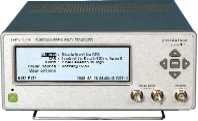
Request Information
Refurbished
The GPS-12R frequency standard offers traceable Cesium-like stability at a very attractive price. Synchronized to the GPS satellite system, the GPS-12R provides both short and long–term time and frequency stability, assuring precision and accuracy. Standard configuration includes three front-panel outputs: two switchable 1.544 MHz (T1) or 2.048 MHz (E1) outputs; and 1-pps time reference. The ultra-stable, built-in Rubidium atomic clock oscillator offers excellent frequency and time stability, whether in GPS-disciplined mode, or in hold-over mode. Configurable alarming provides easy to read urgent and not-urgent alarms for loss of GPS, loss of antenna connection, hardware failures, and more. User settings and display are selectable for six languages. Where AC Mains voltage is not available, the internal battery operation provides oscillator stability during transportation or in field applications. This feature is ideal for telecommunications requirements such as SDH/PDH/SONET Analyzers, wireless base stations, or public utility field applications where lightweight portability with zero warm-up time and full stability is essential. As an in-house NIST traceable reference standard for calibration or as the master clock for test instruments, the GPS-12R provides a continuous stable and accurate frequency standard. The GPS-12R with optional 1, 5, 10 MHz outputs is the ideal precision reference standard for use in; metrology, radar antenna array systems, pubic utilities, and the electronics industry. The optional battery provides increased efficiency of the GPS-12R when transportation between work stations is required. Configuration Options
|
Pendulum Instruments GPS-12RG Rubidium Frequency Standard datasheet & specifications

